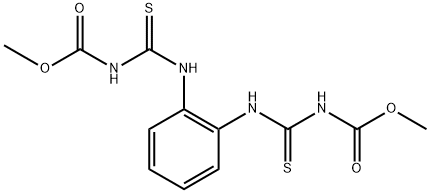????-?? C??? ??, ??, ??
??? ??
colourless crystals, or white or light brown powder
??
Thiophanate-Methyl is a systematic fungicide of the thiophanate class. Thiophanate-Methyl is commonly used in agriculture to protect against powdery mildew, rot and other fungal diseases in fruits, ve
getables and other crops.
??
ChEBI: A member of the class of thioureas that is the dimethyl ester of (1,2-phenylenedicarbamothioyl)biscarbamic acid. A fungicide effective against a broad spectrum of diseases in fruit, vegetables, turf and other crops including eyespot, scab, powdery mildew a
d grey mould.
?? ??
Colorless crystals or light brown powder.
??? ?? ??
Insoluble in water.
?? ???
Thiophanate-methyl is incompatible with strong acids and bases, and with strong reducing agents such as hydrides. Produces flammable gaseous hydrogen with active metals or nitrides. Incompatible with strong oxidizing acids, peroxides. Incompatible with alkaline material. Forms complexes with copper salts .
????
Flash point data for Thiophanate-methyl are not available. Thiophanate-methyl is probably combustible.
???
Fungicide: Thiophanate-methyl is a systemic fungicide used to
control a broad spectrum of fungal diseases on fruits, vegetables,
turf and ornamentals, including shade trees, and diseases
in the field, nurseries, and in greenhouses. Note: Do not
confuse with thiophanate-ethyl (CAS: 23564-06-9), which is
not currently registered for use in the U.S. Registered for use
in EU countries. Registered for use in the U.S.
???
BASF® 32500 F; BASF® 32500 Fungicide;
CERCOBIN®; CLEARY® 3336; CONSYST®;
DITEK®[C]; DOMAIN®; DOUSAN®[C]; ENOVIT®;
EVOLVE®; FANATE®; FUNGITOX®; FUNGO®;
MILDOTHANE® Turf Liquid; NEOTOPSIN®; NF-
35®; NF-44®; NSC 170810®; PELT®; PRO-TURF®;
SIPCAVIT®; SNARE®; SPECTRO®; SYSTEC®;
SYSTEMIC® FUNGICIDE; TD 1771®; TOPSIN®;
TOPSIN-WP METHYL®; 3336 TURF FUNGICIDE®;
ZYBAN®
??? ??
Methyl thiophanate is thiocarbamate ester, used in the synthesis of polymers and in agriculture as pesticides, soil fumigants, and seed disinfectants.
Carcinogenicity
Those long-term studies evaluated a
variety of toxicity end points including carcinogenicity.
Both benomyl and carbendazim were weak carcinogens in
some in vivo studies. Rats of the SpDxAug strain were fed 80,
400, and 2000 ppm for 2 years and no evidence for an
increase in tumors was seen. In carcinogenicity
studies in mice with carbendazim, similar liver tumor finding
were found in CD-1 or Swiss strains. On the other
hand, no evidence of tumors was seen in a similar study
conducted using the NMRKf mouse strain, a strain that has a
low incidence of spontaneous tumors.
?? ?? ??
Thiophanate methyl degradation in water (hydrolytic/ photolysis), soils,
plants and animals follows a common pathway that involves the initial
conversion into methyl benzimidazol-2-ylcarbamate (carbendazim).
Prior to benzimidazole ring formation, at least one side chain undergoes
an oxidative desulfuration reaction and partial hydrolysis (even to
the substituted aniline). Once formed, carbendazim is degraded primarily
via an oxidative mechanism (in animals) or through hydrolysis
to 2-aminobenzimidazole (in soils). Possible metabolism pathways of
thiophanate methyl are depicted in Scheme 1.
?? ??
UN2771 Thiocarbamate pesticides, solid, toxic, Hazard Class: 6.1; Labels: 6.1-Poisonous materials. UN3077 Environmentally hazardous substances, solid, n.o.s., Hazard class: 9; Labels: 9-Miscellaneous hazardous material, Technical Name Required.
? ???
Thiocarbamate esters are combustible; dust may form explosive mixture with air. Decomposes163℃Thiocarbamate esters are combustible. They react violently with powerful oxidizers such as calcium hypochlorite. Poisonous gases are generated by the thermal decomposition of thiocarbamate compounds, including carbon disulfide, oxides of sulfur, oxides of nitrogen, hydrogen sulfide, ammonia, and methylamine. Thio and dithio carbamates slowly decompose in aqueous solution to form carbon disulfide and methylamine or other amines. Such decompositions are accelerated by acids. Flammable gases are generated by the combination of thiocarbamates with aldehydes, nitrides, and hydrides. Thiocarbamates are incompatible with acids, peroxides, and acid halides.
??? ??
In accordance with 40CFR 165 recommendations for the disposal of pesticides and pesticide containers. Must be disposed properly by following package label directions or by contacting your local or federal environmental control agency, or by contacting your regional EPA office. Consult with environmental regulatory agencies for guidance on acceptable disposal practices. Generators of waste containing this contaminant (≥100 kg/mo) must conform with EPA regulations governing storage, transportation, treatment, and waste disposal.
????-?? ?? ?? ? ???
???
?? ??









